| CPC H04W 36/22 (2013.01) [G06N 3/044 (2023.01); G06N 3/08 (2013.01); H04W 24/02 (2013.01); H04W 28/0861 (2023.05)] | 15 Claims |

|
1. A method for load balancing in a wireless communication system, the method comprising:
receiving a bandwidth utilization, a number of active user equipments (UEs), and an average throughput from at least one base station (BS);
obtaining first state data based on the bandwidth utilization, the number of active UEs, and the average throughput;
obtaining first action data associated with an active UE load balancing (AULB) and first goal data for obtaining second action data, by inputting the first state data and first reward data to a first reinforcement learning model;
obtaining second action data associated with an Idle UE load balancing (IULB), by inputting the first state data, the first goal data, and second reward data to a second reinforcement learning model;
determining third action data associated with both the AULB and the IULB, based on the first action data and the second action data; and
transmitting the third action data to the at least one base station (BS).
|